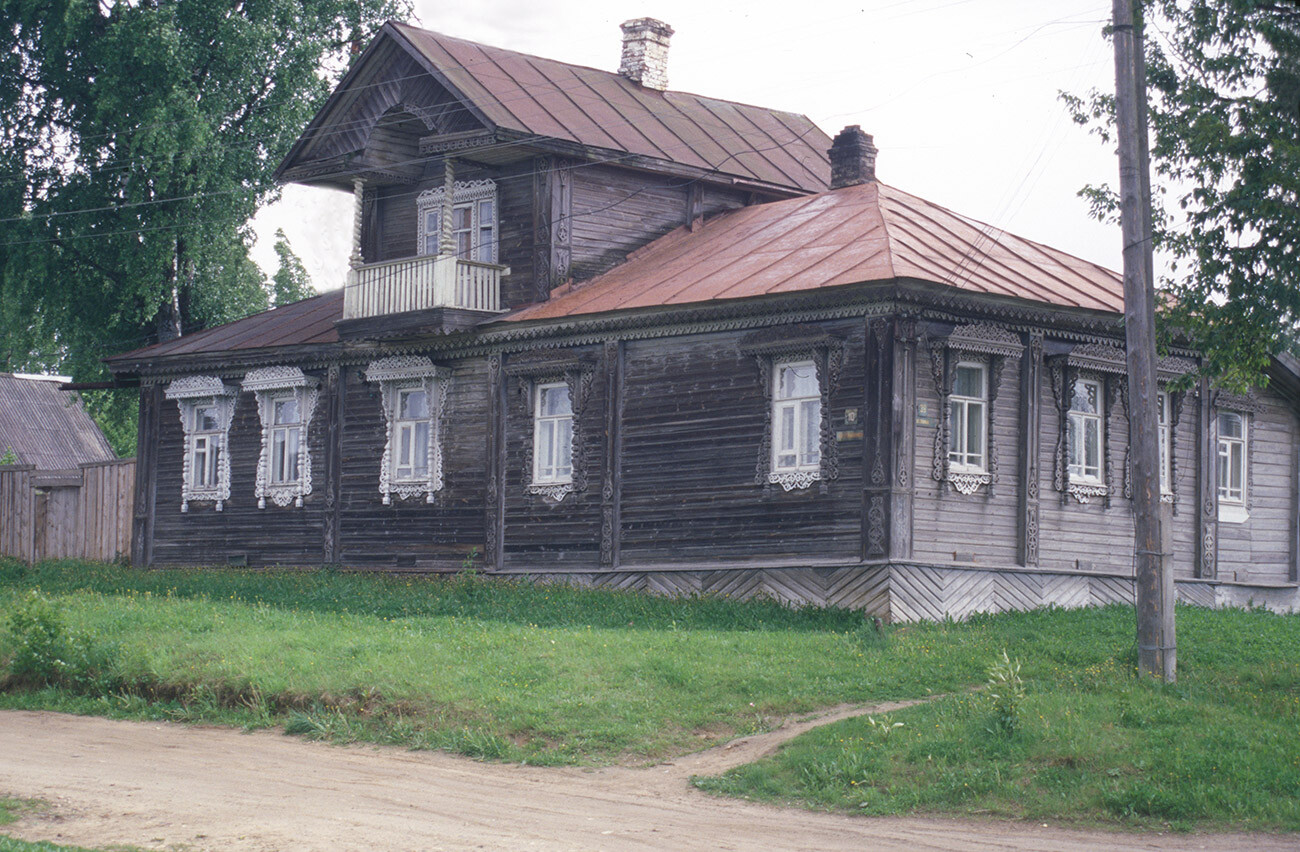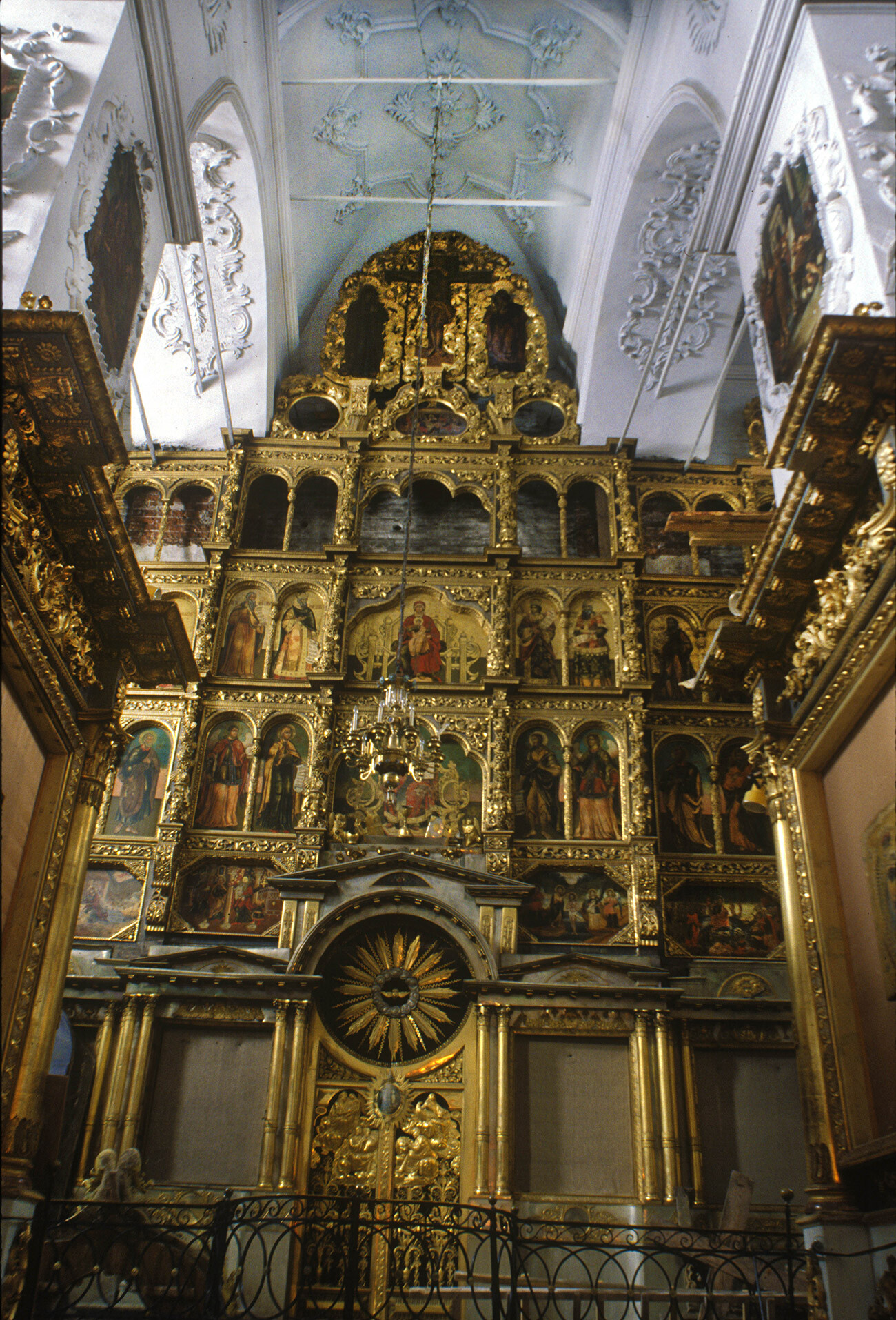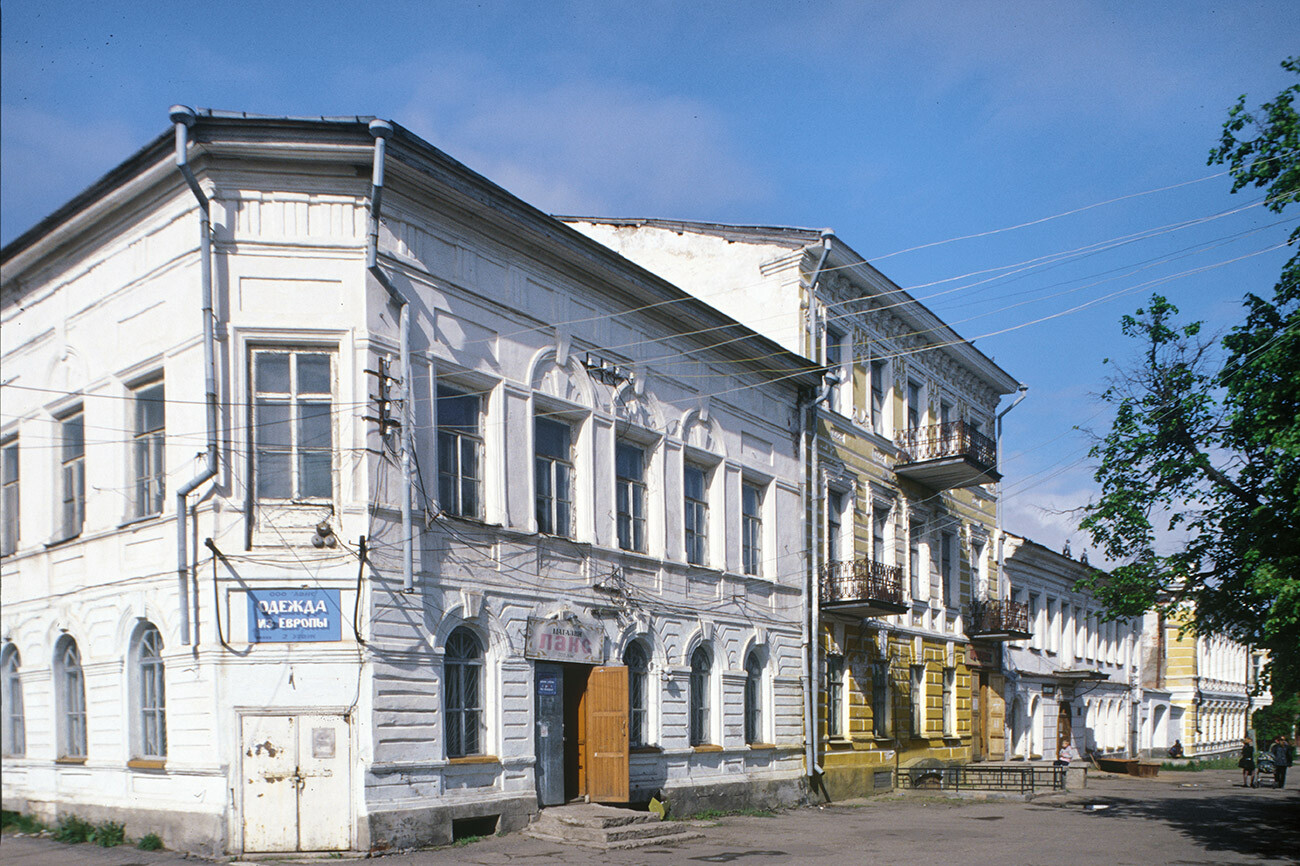Ustyuzhna: A center of Stroganov art

 Ustiuzhna. Boborykin house, Rosa Luxemburg Street 10. Excellent example of town wooden house with "mezzanine" and balcony beneath extended roof. May 22, 2001
Ustiuzhna. Boborykin house, Rosa Luxemburg Street 10. Excellent example of town wooden house with "mezzanine" and balcony beneath extended roof. May 22, 2001
At the beginning of the 20th century, Russian chemist and photographer Sergey Prokudin-Gorsky developed a complex process for vivid, detailed color photography. Inspired to use this new method to record the diversity of the Russian Empire, he photographed historic sites over a vast geographical range during the decade before the start of World War I.
Logistical support for his journeys came from the Ministry of Transportation, which commissioned him to photograph in June and July 1909 along the Mariinsky Waterway in northwestern Russia. This water route was intrinsically connected with the development of St. Petersburg, founded in 1703 and designated the capital of Russia in 1712.
Connecting the empire
 Cherepovets. View north from right bank of Sheksna River. From left: Trinity Cathedral (demolished ca. 1951), Resurrection Cathedral (above). Far right: Yagorba River. Summer 1909
Cherepovets. View north from right bank of Sheksna River. From left: Trinity Cathedral (demolished ca. 1951), Resurrection Cathedral (above). Far right: Yagorba River. Summer 1909
Faced with the challenge of supplying the new capital with grain and other commodities from the interior of the country, Peter the Great initiated a transportation network between St. Petersburg and the Volga River basin. This waterway was further developed during the reign of Emperor Paul (1796-1801), who named it after his consort, Empress Maria Feodorovna.
The Mariinsky Waterway system extended from the Neva River in St. Petersburg through Lake Ladoga to Beloe Ozero (‘White Lake’). White Lake is drained by the Sheksna River, which flows past Cherepovets, photographed by Prokudin-Gorsky from the river. The Sheksna empties into the Rybinsk Reservoir leading to the Volga River port of Rybinsk.
Slightly to the west, another aquatic path, the Tikhvin Waterway, also flows into the Rybinsk Reservoir. Its main river is the Mologa, on whose banks sits the historic town of Ustyuzhna (population about 7,500). Ustyuzhna is not particularly remote by Russian standards, yet it has no rail link and is several kilometers from the main road between St. Petersburg and Cherepovets.
Metal surge
 Ustiuzhna. Church of Dormition of the Virgin (also Church of Descent of Holy Spirit). Southwest view with left bank of Mologa River. Built in 1781, closed in 1939, used as food-processing plant. May 22, 2001
Ustiuzhna. Church of Dormition of the Virgin (also Church of Descent of Holy Spirit). Southwest view with left bank of Mologa River. Built in 1781, closed in 1939, used as food-processing plant. May 22, 2001
Walking along the town’s quiet streets (many of them unpaved) gives the impression of a provincial trading center that has changed little since the 19th century. The 20th century, however, inflicted much damage to it as in so many other provincial towns.
Although every neighborhood seems to have its church, most of the churches were vandalized or destroyed during the Soviet period. Only one, dedicated to the Kazan Icon of the Virgin, is entirely devoted to worship on a regular basis. Fortunately, this church and its frescoes form a masterpiece of Stroganov religious art.
Ustyuzhna’s wealth in the medieval period was based on nearby deposits of bog iron suited to primitive smelting methods. The town was first noted for its iron in the mid-13th century, when it became one of the earliest Russian centers of metal working. Ustyuzhna reached the height of its iron production during the 16th century.
Cathedral of the Nativity of the Virgin
 Cathedral of Nativity of the Virgin (1690). Southwest view. May 21, 2001
Cathedral of Nativity of the Virgin (1690). Southwest view. May 21, 2001
With the 18th-century development of the Urals as Russia's primary metal producer, Ustyuzhna settled into the status of a modest regional town. A major change in its appearance occurred during the reign of Catherine the Great, who, in the 1770s, brought order into the planning of Russia’s towns. The Ustyuzhna plan, approved in 1778, skillfully connected the two main churches: the Cathedral of the Nativity of the Virgin and the Church of the Kazan Icon.
 Cathedral of Nativity of the Virgin (1690). View east toward icon screen. March 10, 1998
Cathedral of Nativity of the Virgin (1690). View east toward icon screen. March 10, 1998
The Cathedral of the Nativity of the Virgin, built in 1685-1690, is the oldest surviving church in Ustyuzhna. Although its bell tower was demolished in the 1930s, the cathedral's conversion to use by the local history museum no doubt saved it from a worse fate during the Soviet period.
 Cathedral of Nativity of the Virgin. Icon screen, central bay with Crucifix & restored icons of Patriarchs Row (on left). December 30, 2009
Cathedral of Nativity of the Virgin. Icon screen, central bay with Crucifix & restored icons of Patriarchs Row (on left). December 30, 2009
The Nativity Cathedral exterior is relatively simple, but the interior has an extraordinary iconostasis whose style can be traced to work done in the Moscow Kremlin in the late 1680s. Its carved, gilded frame ascends in five rows in the canonical Orthodox pattern, from the Local Row at the bottom to the Patriarchs Row at the top. The cathedral currently serves as the town museum.
Church of the Kazan Icon of the Virgin
Ustyuzhna’s other stunning monument of religious art, the festively decorated Church of the Kazan Icon of the Virgin, was begun in 1694 by Grigory Stroganov (of the renowned Stroganov merchant dynasty), who had commercial dealings in Ustyuzhna.
 Church of Kazan Icon of the Virgin (1694). South view with cemetery. May 21, 2001
Church of Kazan Icon of the Virgin (1694). South view with cemetery. May 21, 2001
The exterior of the Kazan Icon Church bears a resemblance to other Stroganov churches of the late 17th century. Their red painted brick facades are decorated with the white detailing of structural and decorative elements. These churches typically culminate in ornamental cupolas crowned with tall, elaborate crosses.
 Church of Kazan Icon of the Virgin (1694). West (main) portal with ceramic decoration. View from narthex. August 7, 2009
Church of Kazan Icon of the Virgin (1694). West (main) portal with ceramic decoration. View from narthex. August 7, 2009
Unlike other Stroganov churches, the Kazan Church is all on one level, without a lower chapel under the main sanctuary. The original entrance to the church was a covered porch projecting from the west facade and leading to a small vestibule, or narthex (papert’). A one-story chapel with an altar to Saint Catherine was attached to the north facade. This compact space was heated for worship in the winter.
 Church of Kazan Icon of the Virgin (1694). Icon screen. August 7, 2009
Church of Kazan Icon of the Virgin (1694). Icon screen. August 7, 2009
The interior of the Kazan Church contains a soaring iconostasis, but its glory is the full array of mid 18th-century frescoes, painted in a robust style by masters from Yaroslavl, one of the most important centers of Russian religious painting in the 17th and 18th centuries.
 Church of Kazan Icon of the Virgin. Ceiling and dome. August 7, 2009
Church of Kazan Icon of the Virgin. Ceiling and dome. August 7, 2009
During this period, its artistic style was influenced by Western religious art and by illustrated Bibles of Western origin, which were familiar to local artists.
Ustyuzhna frescoes
 Church of Kazan Icon of the Virgin. North wall with frescoes of icons of the Virgin. August 7, 2009
Church of Kazan Icon of the Virgin. North wall with frescoes of icons of the Virgin. August 7, 2009
There is precise information on when and by whom the Ustyuzhna frescoes were painted. The arch framing the entrance from the vestibule to the north chapel displays an inscription with the dates (July 1, 1756 to August 26, 1757) and the names of a group of artists from Yaroslavl.
 Church of Kazan Icon of the Virgin. Narthex, east wall with fresco of Last Judgement. August 7, 2009
Church of Kazan Icon of the Virgin. Narthex, east wall with fresco of Last Judgement. August 7, 2009
The frescoes begin in the small narthex, which includes the ‘Seven Days of Creation’, the ‘Expulsion from Paradise’ and the ‘Last Judgment’. The interior of the main structure creates an overwhelming impression, with depictions of the Passion of Christ, major church festivals, images of the Virgin Mary and scenes from the vita of St. Catherine.
Magnificent architecture
 Church of the Annunciation (1762). North view. May 21, 2001
Church of the Annunciation (1762). North view. May 21, 2001
The portal leads to a soaring space covered in one of the most colorful displays in Russian religious art. The impact is heightened by the design of an unobstructed interior, which rises to a high-pitched vault with a single opening for the main cupola. The thick exterior walls carry the entire weight of the structure, yet the two levels of windows admit ample light to illuminate the frescoes.
 Church of the Intercession of the Virgin (also Nativity of Christ). Built in 1780 on left bank of Mologa River. August 12, 2006
Church of the Intercession of the Virgin (also Nativity of Christ). Built in 1780 on left bank of Mologa River. August 12, 2006
The four sides of the high vault display eight solemn holy days of the Russian Orthodox calendar: the Annunciation, the Nativity of Christ, the Purification, the Epiphany (Baptism of Christ), the Transfiguration, the Pentecost, the Nativity of the Virgin, and the Presentation of the Virgin. They are encompassed by a narrative band of frescoes depicting scenes from the Passion of Christ.
 Store & N. I. Pozdeev house on Trading Square. May 21, 2001
Store & N. I. Pozdeev house on Trading Square. May 21, 2001
The walls themselves are divided into four horizontal rows. The upper two are connected with the life and teachings of Christ, including parables such as The Laborer in the Vineyard and The Prodigal Son. The third row from the top is devoted largely to “Acts of the Apostles”, including episodes from the lives of Saints Peter and John.
 Ya. M. Pozdeev house (now town library). August 12, 2006
Ya. M. Pozdeev house (now town library). August 12, 2006
The bottom row is devoted to scenes from the life of Saint Catherine. The middle row of frescoes is interrupted with large images, such as the Miraculous Icon of the Savior and a representation of Mary and the Christ Child in the manner of Raphael.
 A. V. Zhilin house, Karl Marx Street 10. December 30, 2009
A. V. Zhilin house, Karl Marx Street 10. December 30, 2009
In addition to the wall frescoes, there are images on the upper level of the thick window emplacements. The window arches are clearly visible and include images, such as the Savior Emmanuel, as well as several variants of the Virgin, appropriate in view of the church's dedication to the Kazan Icon of the Virgin.
 Former City Council (duma) building with fire tower. The entire wooden structure of this national landmark, built in 1887, burned at the end of 2000. March 10, 1998
Former City Council (duma) building with fire tower. The entire wooden structure of this national landmark, built in 1887, burned at the end of 2000. March 10, 1998
The final component of the ensemble is the separate bell tower, a tall octagonal brick structure with a conical roof. It was constructed by Petr Beliavin in the same year as the painting of the frescoes.
 Nikolay Kurbatov house, Ustiug Lane 4. Built in late 19th century with attached log tower. Upper tiers of tower removed in 2009. May 22, 2001
Nikolay Kurbatov house, Ustiug Lane 4. Built in late 19th century with attached log tower. Upper tiers of tower removed in 2009. May 22, 2001
As for secular architecture, a small core of the town’s 19th-century commercial buildings has survived, along with several wooden houses, some of which have been abandoned as the population declines.
 Log water tower, corner of Veselov & Rosa Luxemburg Streets. Built in late 19th century. August 12, 2006
Log water tower, corner of Veselov & Rosa Luxemburg Streets. Built in late 19th century. August 12, 2006
Despite severe losses during the 20th century, the historic center of Ustyuzhna, with its surviving treasures of religious art, evokes the rich cultural heritage of Russia’s northern towns.
 Wooden school with lilac in bloom on left bank of Mologa River. May 22, 2001
Wooden school with lilac in bloom on left bank of Mologa River. May 22, 2001
In the early 20th century, Russian photographer Sergey Prokudin-Gorsky developed a complex process for color photography. Between 1903 and 1916, he traveled through the Russian Empire and took over 2,000 photographs with the process, which involved three exposures on a glass plate. In August 1918, he left Russia and ultimately resettled in France, where he was reunited with a large part of his collection of glass negatives, as well as 13 albums of contact prints. After his death in Paris in 1944, his heirs sold the collection to the Library of Congress. In the early 21st century, the Library digitized the Prokudin-Gorsky Collection and made it freely available to the global public. A few Russian websites now have versions of the collection. In 1986, architectural historian and photographer William Brumfield organized the first exhibit of Prokudin-Gorsky photographs at the Library of Congress. Over a period of work in Russia beginning in 1970, Brumfield has photographed most of the sites visited by Prokudin-Gorsky. This series of articles juxtaposes Prokudin-Gorsky’s views of architectural monuments with photographs taken by Brumfield decades later.

